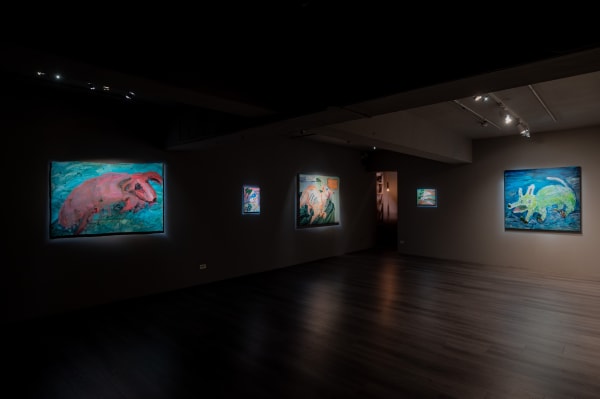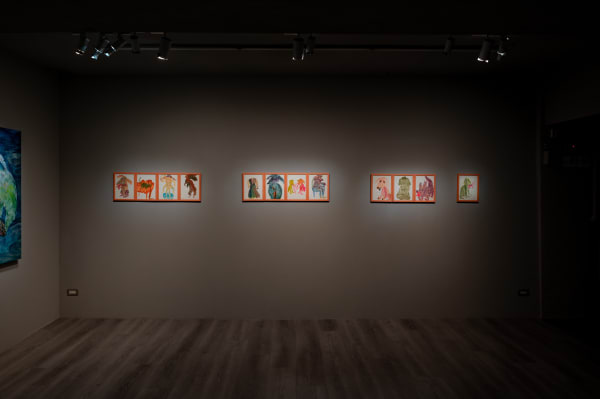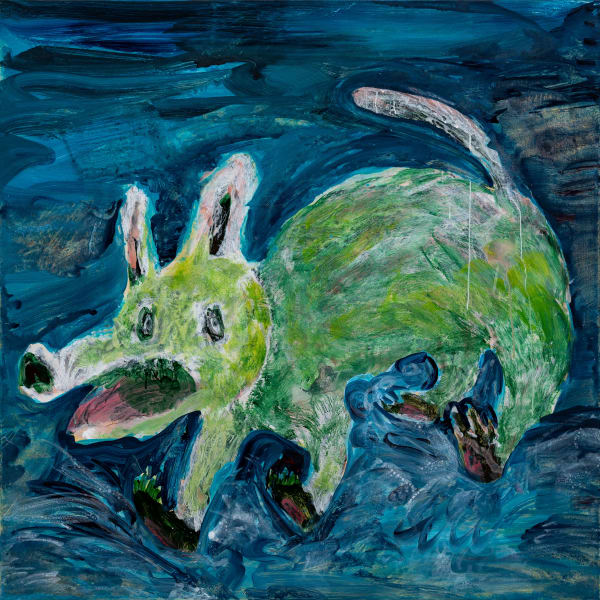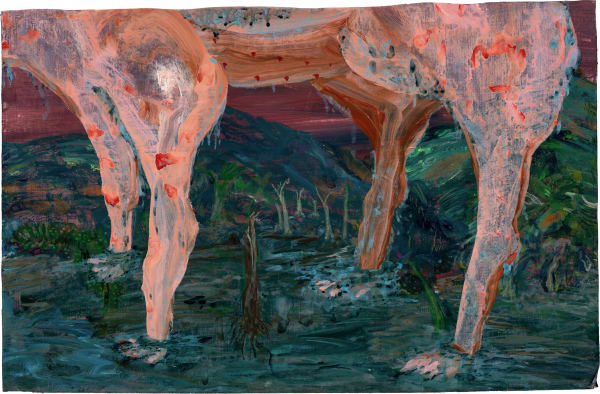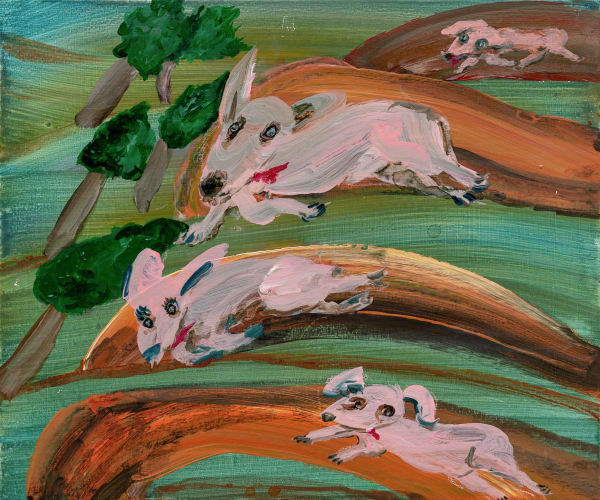Cai Ruei-Heng:Slippery Game
Reasons for Running Again
Text/ Chen Hsi
It has started running again.
Perhaps, the last time it did so was years ago, when it escaped from the factory that engendered its sense of alienation. The story of passion came to an end, while reality continued on. Those existential anxieties, once embodied by ghosts and flesh, are now transmuted into acrylic paint and fluid atmosphere.
These fluid atmospheres are the captivating amalgamation of wetness, transparency, and turbidity in Cai Ruei-Heng's paintings. Starting at the bottom of the canvas, the brushstrokes meticulously constructs the scene, as each individual stroke leaves behind an unadorned sense of speed, creating the image of a dog (to me, it just happens to appear like a dog). His method of drawing, which involves a mixture of layers and textures, reminds one of glazing, but during the actual process, the artist intentionally allows the paints to not fully dissolve into the surface, creating translucent passages that enable the viewer to glimpse the emotions revealed from the fluidity of the medium underlying the thin layers within the pictorial space.
Cai Rui-Heng's earlier approach to brushstrokes and murky color expressions were largely interpreted as a means of expressing his internal repression. Perhaps this was related to his motivation for pursuing painting. Originally, he studied in a technical field but felt alienated from the prospect of a career after graduation. By chance, he began studying in a private painting studio, which opened up the path of painting for him.
At that time, the characters in Cai Ruei-Heng's works often showed a dynamic sense of escaping from a certain scene. For example, in the work "Factory Variant" (2017) exhibited in the exhibition "Ugly" of the YIRI ARTS, the distant relationship between scenes and the dynamic sense of paint splattering were shown. A dog running out of the picture from a meat production line, even if it became almost like a lump of meat, still had the breath of escaping. In "Director is Not Here 3" (2021) exhibited in the same exhibition at the time, I even speculated whether he, who "changed careers" and became a painter after graduation, reflected the state of alienation of painters in the contemporary art world in the previous series of paintings.
The relationship between the brushstrokes and colors in Cai Ruei-Heng's paintings seems like a turbulent flow that is about to break through the form. However, after the passion subsides, the problems do not leave. The stickiness and melancholy after the vent often make the characters in Cai Ruei-Heng's previous paintings, even if they are motionless, churn up a myriad of emotions in the muddy and translucent colors. After leaving the factory to study painting at the Taipei National University of the Arts, he gradually immersed himself in understanding the fluid atmosphere expressed in the paint. With less dynamic sense, many of the painter's works after graduation from the academy focus on the environment (scene) in the painting. From the base color brushing the main tone, layer by layer adding different faces, and sometimes deliberately allowing the colors to blend with each other, he retains his inherent and simple turbidity. Perhaps this is reminiscent of the large-scale smear and floating and twisted images of Irish artist Genieve Figgis, but the liquid flow texture of the paint in Cai Ruei-Heng's paintings is often stronger than the image composition, which may be the key difference between the two painters in the visual and material aspects of painting.
Until now, Cai Rui-Heng has not abandoned the "bad dog" in his art practice. Dogs, in many famous artists' works, can be considered a special category that can resonate with and project oneself. In Cai Rui-Heng's practices, his imagination, interpretation, and depiction of dogs are more inclined towards self-compensation when facing daily living environments. Like dogs, he is happy, runs towards objects that bring him joy, and flees like a dog when needed.
Cai Rui-Heng exhibited his paper works for the first time in "Slippery Game," where he not only reflected his personality in the expressions of dogs but also showed his skillful ability to "slide" various shapes on watercolor paints. Notably, in the "Ghostly Dress" series, he depicted ghosts wearing dresses, and in the "Swamp Beast," he focused on the material texture, adding more detailed elements to the scenery in the painting, making it a rare composition in his series.
Looking at Cai Ruei-Heng's practices in this context, I was amazed by the emotional tension interwoven through the scenery, layering of brushstrokes, and fluid atmosphere in 'Slippery Game.’ The dog running towards the edge of the painting with its tongue out is no different from the flowers that have wilted on the shelf, as both strive to follow their instinct to the light before collapsing. It represents the expression of joy from seeing something in a malignant place, the moment when they are saved from isolation due to some form of connection, and it is the reason for it to start running again.
-
 蔡瑞恒 Cai Ruei-Heng濕滑賽局 Slippery Game, 2023Acrylic on canvas145.5 × 112 × 5 cm
蔡瑞恒 Cai Ruei-Heng濕滑賽局 Slippery Game, 2023Acrylic on canvas145.5 × 112 × 5 cm -
 蔡瑞恒 Cai Ruei-Heng受驚的朋友 Friend of Scared, 2023Acrylic on canvas120 × 120 × 5 cm
蔡瑞恒 Cai Ruei-Heng受驚的朋友 Friend of Scared, 2023Acrylic on canvas120 × 120 × 5 cm -
 蔡瑞恒 Cai Ruei-Heng沼澤巨獸 Swamp Beast, 2023Acrylic on canvas86 × 56 × 3 cm
蔡瑞恒 Cai Ruei-Heng沼澤巨獸 Swamp Beast, 2023Acrylic on canvas86 × 56 × 3 cm -
 蔡瑞恒 Cai Ruei-Heng衝出池膜 Breaking the Surface, 2023Acrylic on canvas140 × 103 × 3 cm
蔡瑞恒 Cai Ruei-Heng衝出池膜 Breaking the Surface, 2023Acrylic on canvas140 × 103 × 3 cm -
 蔡瑞恒 Cai Ruei-Heng賽車手 Racer, 2023Acrylic on canvas45.5 × 38 × 2 cm
蔡瑞恒 Cai Ruei-Heng賽車手 Racer, 2023Acrylic on canvas45.5 × 38 × 2 cm -
 蔡瑞恒 Cai Ruei-Heng超時空賽跑 Interdimensional Race, 2023Acrylic on canvas38 × 45.5 × 2 cm
蔡瑞恒 Cai Ruei-Heng超時空賽跑 Interdimensional Race, 2023Acrylic on canvas38 × 45.5 × 2 cm -
 蔡瑞恒 Cai Ruei-HengHotdog #5, 2023Acrylic on canvas29.5 × 21 cm
蔡瑞恒 Cai Ruei-HengHotdog #5, 2023Acrylic on canvas29.5 × 21 cm -
 蔡瑞恒 Cai Ruei-HengHotdog #6, 2023Acrylic on canvas29.5 × 21 cm
蔡瑞恒 Cai Ruei-HengHotdog #6, 2023Acrylic on canvas29.5 × 21 cm -
 蔡瑞恒 Cai Ruei-HengHotdog #3, 2023Acrylic on canvas29.5 × 21 cm
蔡瑞恒 Cai Ruei-HengHotdog #3, 2023Acrylic on canvas29.5 × 21 cm -
 蔡瑞恒 Cai Ruei-HengHotgirl #1, 2023Acrylic on canvas29.5 × 21 cm
蔡瑞恒 Cai Ruei-HengHotgirl #1, 2023Acrylic on canvas29.5 × 21 cm

